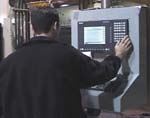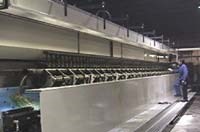Controller Helps Meet Demand For Foreign Oil
The cutting of thousands of slots in extensive lengths of pipe requires large-scale machining, and the demand for such pipe is steadily increasing as Middle East oil sources become less dependable. Controls on these machines are crucial.
Share




Mention the term "foreign oil," and you'll likely conjure images of Arabian Desert landscapes dotted with wells, presided over by sheiks of inconceivable wealth. But for the United States, "foreign oil" can originate from somewhere much closer, including from its northern neighbor in the upper reaches of the Canadian province of Alberta.
As the supply and pricing turmoil common to Middle East oil reaches one of its periodic peaks, the petroleum industry looks more and more to other parts of the globe to satisfy the insatiable thirst for crude. In many ways, that's a boon to companies such as Almac Machine Works Ltd., a highly versatile Edmonton, Alberta, firm that offers a variety of machining and fabrication services to clients participating in or serving the oil industry.
"It's a little bit like Texas here," says Almac's special projects manager Fred Harmat. "Up here, lots of businesses are tied to the oil industry."
Among many other oil-related projects, Mr. Harmat recently produced a gigantic new machine tool that helps make possible the extraction of some of the less accessible crude oil in the Canadian fields.
Since much Canadian crude oil is found mixed with sand, shale and other substances, special tools must be used to remove it, through the employment of a steam injection process. These tools include slotted pipes that are positioned horizontally deep in the earth, acting as screens in the process of extracting oil from surrounding minerals.
The cutting of thousands of slots in extensive lengths of pipe requires large-scale machining, and the demand for such pipe is steadily increasing as Middle East oil sources become less dependable. That's why one of Almac's clients, Slotwell, Inc., had Almac Machine Works create several huge machine tools expressly for the purpose of cutting slots in pipe.
The newest of these machine tools is a true behemoth at 65 feet long. It incorporates 80 milling spindles, each of which is positioned 6 inches apart and fitted with a circle-R-type cutter. One reason why such an imposing and sophisticated machine tool is required for this purpose is the fact that so many different kinds of pipe are required by the Canadian oil industry. Different quantities, sizes and shapes of slots on different sizes of pipe might be needed. And the machine tool produced by Almac had to be able to produce slotted pipe in all of this mind-boggling variety. That's why the company incorporated a Siemens Energy & Automation SINUMERIK 810D controller.
"The beauty of the device lies in the control of all these servos with a single Siemens Control," Mr. Harmat says. "It all has to do with flexibility. Other people who have tried this kind of thing have had problems controlling so many motors, tying them together in a single unit. Plus, there's the complication of incorporating three axes plus a rotary axis, which is a full servo in itself."
The sheer size and scale of what the tool accomplishes makes hassle-free automated control essential to its operation, and the SINUMERIK 810D provides the flexibility needed to add special programming options.
"We had to be able to monitor each cutting blade for breakage," Mr. Harmat says, "and with 80 cutters operating at once on one machine, that can be very difficult. The 810D system lets us program in automated monitoring. So, instead of the operator having to run up and down visually checking for breaking blades, he has the option of assigning in a value—such as two broken blades. Then the machine can tell the operator how many blades are broken, and, if a certain assigned quantity is exceeded, the machine can stop. It also tells the operator the location of the broken blades, so they can be changed, and the operator can continue cutting."
Another capability programmed into the system is automatic monitoring of the load on each spindle. "Let's say you have X number of cutters that are getting dull. When that happens, other parts of the system start getting overloaded. And you don't want stalls to happen, because if your cutter is not rotating, you can break the cutter or damage the machine itself. So, when you're getting to a situation where you start to stall, the subprogram kicks in and starts to back off on the feed rate to compensate. It's like a safety. The machine tries to achieve the assigned value for the feedrate but cuts back if overloading is occurring. At the same time, it lets the operator know that a certain station is overloading.
"This, of course, was made possible by the openness of the Siemens SINUMERIK product. It gave us the capability to add the additional programming we needed to the system. We required custom subrouting, and the Siemens product, with its great openness, gave us the flexibility to add it with no problem."
Another advantage the Siemens SINUMERIK 810D control brings to the machine is its comparative simplicity of operation. "Not much training is involved," says Mr. Harmat. "The parameters are fairly simple—setting cutting speeds, numbers of slots, length of slots. In general, if you're familiar with CNC, there's nothing really exotic happening here. It's just that there's such a large number of cutters. It's fast, and it's fully automated. If you don't experience any breakage, the thing just goes."
Mr. Harmat says the company diversifies from bigger outfits that find it cost prohibitive to build customized machines. "We've been able to capture a niche in the market," he says. Using Siemens products in its projects, Almac plans to further expand its operations in the area of custom machine tool design and manufacturing. And, as the oil industry continues to evolve, it's expected that Almac's expertise and creativity will experience rapid growth and demand in oil producing areas all over the globe.
Related Content
5 Tips for Running a Profitable Aerospace Shop
Aerospace machining is a demanding and competitive sector of manufacturing, but this shop demonstrates five ways to find aerospace success.
Read MoreCan ChatGPT Create Usable G-Code Programs?
Since its debut in late 2022, ChatGPT has been used in many situations, from writing stories to writing code, including G-code. But is it useful to shops? We asked a CAM expert for his thoughts.
Read MoreCan AI Replace Programmers? Writers Face a Similar Question
The answer is the same in both cases. Artificial intelligence performs sophisticated tasks, but falls short of delivering on the fullness of what the work entails.
Read MoreContinuous Improvement and New Functionality Are the Name of the Game
Mastercam 2025 incorporates big advancements and small — all based on customer feedback and the company’s commitment to keeping its signature product best in class.
Read MoreRead Next
Building Out a Foundation for Student Machinists
Autodesk and Haas have teamed up to produce an introductory course for students that covers the basics of CAD, CAM and CNC while providing them with a portfolio part.
Read More5 Rules of Thumb for Buying CNC Machine Tools
Use these tips to carefully plan your machine tool purchases and to avoid regretting your decision later.
Read MoreSetting Up the Building Blocks for a Digital Factory
Woodward Inc. spent over a year developing an API to connect machines to its digital factory. Caron Engineering’s MiConnect has cut most of this process while also granting the shop greater access to machine information.
Read More

























.jpg;maxWidth=300;quality=90)








